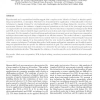Free Online Productivity Tools
i2Speak
i2Symbol
i2OCR
iTex2Img
iWeb2Print
iWeb2Shot
i2Type
iPdf2Split
iPdf2Merge
i2Bopomofo
i2Arabic
i2Style
i2Image
i2PDF
iLatex2Rtf
Sci2ools
IJON
2007
2007
Extraction of spatio-temporal primitives of emotional body expressions
Experimental and computational studies suggest that complex motor behavior is based on simpler spatiotemporal primitives, or synergies. This has been demonstrated by application of dimensionality reduction techniques to signals obtained by electrophysiological and EMG recordings during the execution of limb movements. However, the existence of spatio-temporal primitives on the level of the joint angle trajectories of complex full-body movements remains less explored. Known blind source separation techniques, like PCA and ICA, tend to extract relatively large numbers of sources from such trajectories that are typically difficult to interpret. For the example of emotional human gait patterns, we present a new non-linear source separation technique that treats temporal delays of signals in an efficient manner. The method allows to approximate high-dimensional movement trajectories very accurately based on a small number of learned spatio-temporal primitives or source signals. It is demon...
| Added | 15 Dec 2010 |
| Updated | 15 Dec 2010 |
| Type | Journal |
| Year | 2007 |
| Where | IJON |
| Authors | Lars Omlor, Martin A. Giese |
Comments (0)

